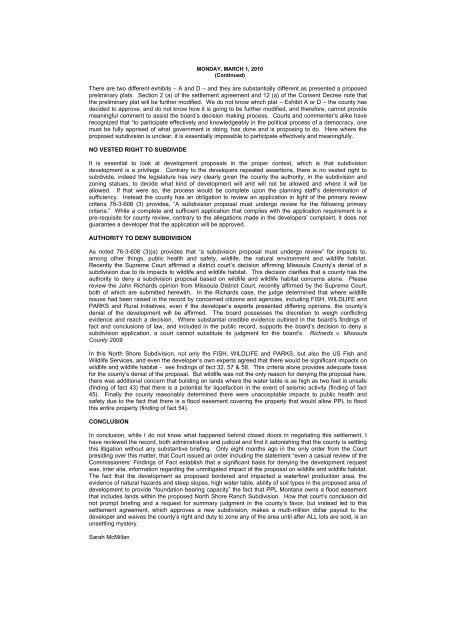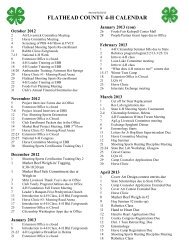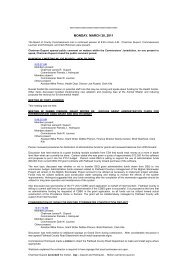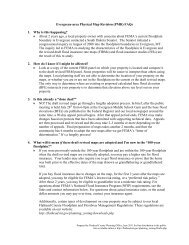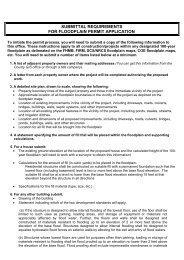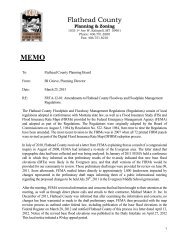MONDAY, MARCH 1, 2010 - Flathead County, Montana
MONDAY, MARCH 1, 2010 - Flathead County, Montana
MONDAY, MARCH 1, 2010 - Flathead County, Montana
You also want an ePaper? Increase the reach of your titles
YUMPU automatically turns print PDFs into web optimized ePapers that Google loves.
<strong>MONDAY</strong>, <strong>MARCH</strong> 1, <strong>2010</strong><br />
(Continued)<br />
There are two different exhibits – A and D – and they are substantially different as presented a proposed<br />
preliminary plats. Section 2 (a) of the settlement agreement and 12 (a) of the Consent Decree note that<br />
the preliminary plat will be further modified. We do not know which plat – Exhibit A or D – the county has<br />
decided to approve, and do not know how it is going to be further modified, and therefore, cannot provide<br />
meaningful comment to assist the board‟s decision making process. Courts and commenter‟s alike have<br />
recognized that “to participate effectively and knowledgeably in the political process of a democracy, one<br />
must be fully apprised of what government is doing, has done and is proposing to do. Here where the<br />
proposed subdivision is unclear, it is essentially impossible to participate effectively and meaningfully.<br />
NO VESTED RIGHT TO SUBDIVIDE<br />
It is essential to look at development proposals in the proper context, which is that subdivision<br />
development is a privilege. Contrary to the developers repeated assertions, there is no vested right to<br />
subdivide, indeed the legislature has very clearly given the county the authority, in the subdivision and<br />
zoning statues, to decide what kind of development will and will not be allowed and where it will be<br />
allowed. If that were so, the process would be complete upon the planning staff‟s determination of<br />
sufficiency. Instead the county has an obligation to review an application in light of the primary review<br />
criteria 76-3-608 (3) provides, “A subdivision proposal must undergo review for the following primary<br />
criteria.” While a complete and sufficient application that complies with the application requirement is a<br />
pre-requisite for county review, contrary to the allegations made in the developers‟ complaint, it does not<br />
guarantee a developer that the application will be approved.<br />
AUTHORITY TO DENY SUBDIVISION<br />
As noted 76-3-608 (3)(a) provides that “a subdivision proposal must undergo review” for impacts to,<br />
among other things, public health and safety, wildlife, the natural environment and wildlife habitat.<br />
Recently the Supreme Court affirmed a district court‟s decision affirming Missoula <strong>County</strong>‟s denial of a<br />
subdivision due to its impacts to wildlife and wildlife habitat. This decision clarifies that a county has the<br />
authority to deny a subdivision proposal based on wildlife and wildlife habitat concerns alone. Please<br />
review the John Richards opinion from Missoula District Court, recently affirmed by the Supreme Court,<br />
both of which are submitted herewith. In the Richards case, the judge determined that where wildlife<br />
issues had been raised in the record by concerned citizens and agencies, including FISH, WILDLIFE and<br />
PARKS and Rural Initiatives, even if the developer‟s experts presented differing opinions, the county‟s<br />
denial of the development will be affirmed. The board possesses the discretion to weigh conflicting<br />
evidence and reach a decision. Where substantial credible evidence outlined in the board‟s findings of<br />
fact and conclusions of law, and included in the public record, supports the board‟s decision to deny a<br />
subdivision application, a court cannot substitute its judgment for the board‟s. Richards v. Missoula<br />
<strong>County</strong> 2009<br />
In this North Shore Subdivision, not only the FISH, WILDLIFE and PARKS, but also the US Fish and<br />
Wildlife Services, and even the developer‟s own experts agreed that there would be significant impacts on<br />
wildlife and wildlife habitat - see findings of fact 32, 57 & 58. This criteria alone provides adequate basis<br />
for the county‟s denial of the proposal. But wildlife was not the only reason for denying the proposal here,<br />
there was additional concern that building on lands where the water table is as high as two feet is unsafe<br />
(finding of fact 43) that there is a potential for liquefaction in the event of seismic activity (finding of fact<br />
45). Finally the county reasonably determined there were unacceptable impacts to public health and<br />
safety due to the fact that there is a flood easement covering the property that would allow PPL to flood<br />
this entire property (finding of fact 54).<br />
CONCLUSION<br />
In conclusion, while I do not know what happened behind closed doors in negotiating this settlement, I<br />
have reviewed the record, both administrative and judicial and find it astonishing that the county is settling<br />
this litigation without any substantive briefing. Only eight months ago in the only order from the Court<br />
presiding over this matter, that Court issued an order including the statement “even a casual review of the<br />
Commissioners‟ Findings of Fact establish that a significant basis for denying the development request<br />
was, inter alia, information regarding the unmitigated impact of the proposal on wildlife and wildlife habitat.<br />
The fact that the development as proposed bordered and impacted a waterfowl production area, the<br />
evidence of natural hazards and steep slopes, high water table, ability of soil types in the proposed area of<br />
development to provide “foundation bearing capacity” the fact that PPL <strong>Montana</strong> owns a flood easement<br />
that includes lands within the proposed North Shore Ranch Subdivision. How that court‟s conclusion did<br />
not prompt briefing and a request for summary judgment in the county‟s favor, but instead led to this<br />
settlement agreement, which approves a new subdivision, makes a multi-million dollar payout to the<br />
developer and waives the county‟s right and duty to zone any of the area until after ALL lots are sold, is an<br />
unsettling mystery.<br />
Sarah McMillan


